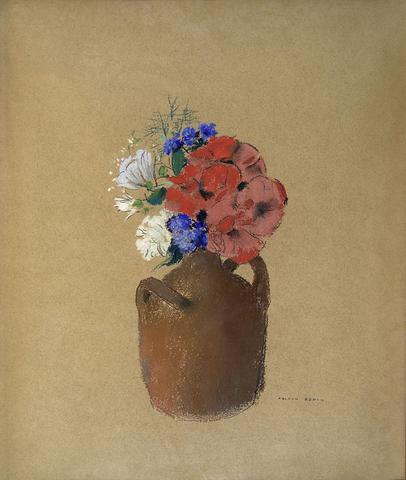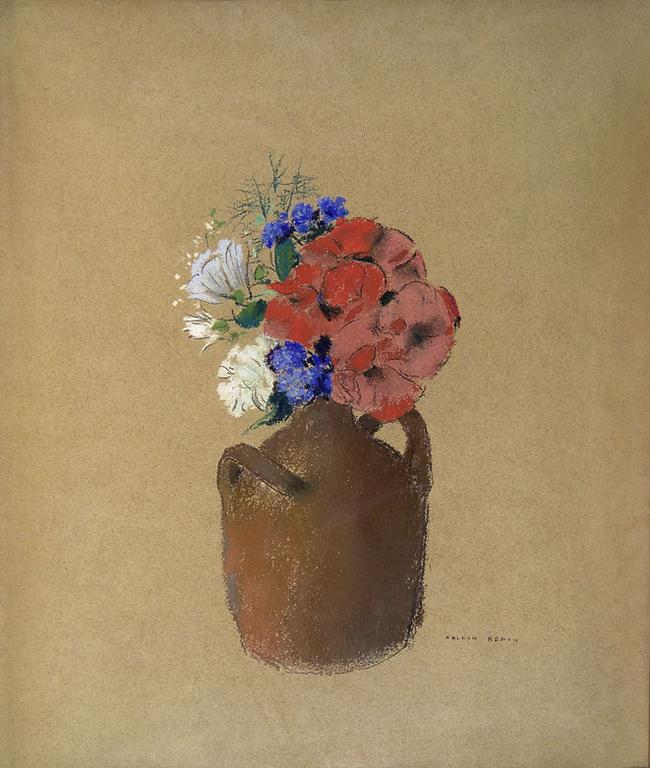
Petit bouquet tricolore
Odilon Redon (1840 Bordeaux - 1916 Paris)
1905
Pastel sur papier ; signé « ODILON REDON » en bas à droite ; 43,9 x 36,2 cm
Provenance :
Paris, Hôtel Drouot, 12 mai 1939 ; Paris, collection Anne Prouvost ; Paris, collection Nathalie Boisson de Chazournes ; Londres, Sotheby’s, 23 juin 2010.
Exposition :
Odilon Redon (galerie Bernheim Jeune, Paris, 1963).
Bibliographie :
Alec Wildenstein, Catalogue raisonné, vol. III, 1996, n° 1426.
Odilon Redon s’exprima longtemps par la lithographie et le fusain (ses célèbres « Noirs »). Après 1890 la couleur prend plus de place dans son œuvre, et à partir de 1900 il peint une série de bouquets, exposés en 1903 et 1906 à la galerie Durand-Ruel et que commente ainsi le peintre Maurice Denis : « Depuis quelques années déjà, il se transforme, il évolue. Il a abandonné sans remords et poussé par une force mystérieuse, les somptueuses harmonies de noir et de blanc où il excellait, il s'est abandonné au plaisir de fixer désormais la splendeur des fleurs diaprées, la sensualité joyeuse des couleurs. » (« Œuvres récentes d'Odilon Redon », L'Occident, avril 1903).
De Manet, à titre d’exercice de peinture pure, à Hockney, expérimentant les possibilités artistiques de l’iPhone, nombreux sont les peintres qui ont eu recours à ce simple motif des fleurs dans un vase. Redon y ajoute un supplément d’âme que résume bien, au même moment, le « Sâr » Péladan, mouche du coche symboliste, meilleur critique d’art au fond que mage : « Celui qui croit que le but de l'art est de reproduire la nature ne peindra rien de durable, car la nature vit. Mais elle n'a point d'entendement. Dans l’œuvre, la pensée doit compenser et remplacer la vie. » (La dernière leçon de Léonard de Vinci, Paris, 1904).
Ce pastel illustre l’extraordinaire capacité de Redon à rendre par les contrastes de formes et de couleurs ce que le critique Bernard Berenson appelait les « valeurs tactiles ». S’inspirant des estampes et paravents japonais en vogue à la fin du 19ème siècle, il juxtapose devant un fond neutre et uni l’exubérance, le velouté des fleurs, et l’austérité, la matité du vase. Jouant d’un camaïeu de tons rouges, il obtient ce qu’il appelle « le tressaillement de la surface colorée par le ton sur ton » (« À soi-même », Journal, Paris, 1922).
Ce modeste vase de grès, ces fleurs coupées atypiques – on ne fait guère dans la bonne société de bouquet de fleurs des champs –, parlent à leur manière de la grandeur des humbles et de l’humilité de l’artiste. Redon, né un an après Cézanne, est ici à mi-chemin des natures mortes intenses, rigoureuses de cet immense peintre, et du travail concentré, lumineux de Giorgio Morandi.
